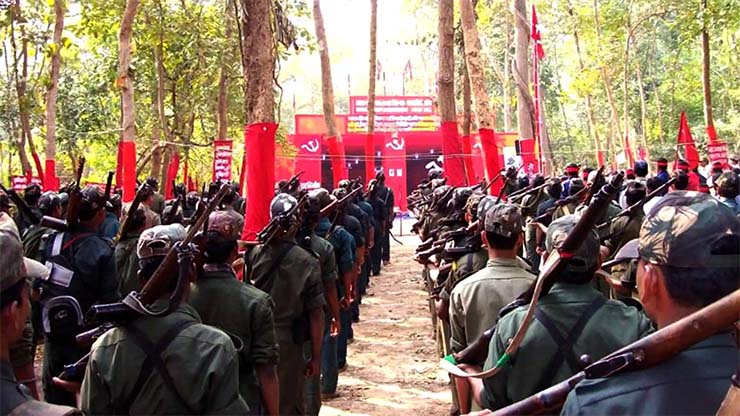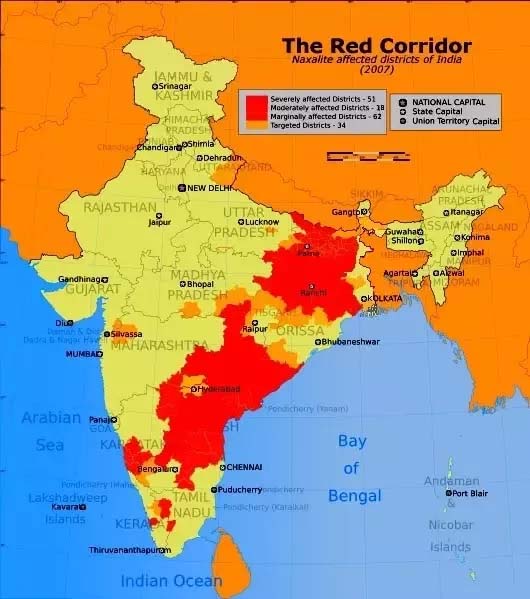
Operation Prahar was in progress on 03 April 2021 since 0530h in thick jungle area between Bijapur and Sukma village led by special Cobra unit [commando battalion for resolute action], Central Reserve Police Force (CRPF) Bastaria battalion, along with special task force (STF) and District reserve guard (DRG) of Chattisgarh state police. The force of approx 2000 troops was subdivided in to five columns of 400 each, launched search and destroy mission from five launch pads namely Tarren, Usroor, Pamed ,Minpa and Narsapuram with an aim to destroy underground camps of No 1 battalion of People liberation guerrilla army ( PLGA) led by Maoist Commander (commander) Madvi Hidma. At 1200 hours afternoon, as leading scouts of Terrain column was approaching Village Tekulguda, they were fired upon from three sides. The troops fired back but heavy automatic fire and mortar bombs rained on them.
They were trapped in the killing ground. Those who rushed for cover in nearby huts, were attacked by reseve party who stabbed them and cut off their limbs. The command and control was lost. There were approx 300/400 Naxals fighting the battle who knew the terrain and were seasoned in jungle warfare. The stunned column commander asked for reinforcement.
The ambush lasted for two hours after which Naxalites withdrew and snatched away seven AK 47 Rifles, two 5.56mm INSAS Rifles, and one Light Machine Gun (LMG). 23 security forces troops were killed ruthlessly, one was missing, and 33 men were severely injured with gunshot and axe wounds. On 04 April, at dawn the intensive search was carried out by reinforced rescue team and dead/wounded were collected at adhoc helipad near Village Tekalguda and evacuated by three IAF MI 17 helicopters to Raipur / Jagdalpur civil hospital. The Naxalites also suffered some casualties. Only one dead body of woman Naxalite was recovered. It was one of the deadliest ambushes in Bastar region after Dantewada ambush of 6 April 2010 in which 76 CRPF personnel were martyred. How long troops will suffer? How long India will bleed by own people? The various party governments (govt) of 11 south eastern/eastern states over last 54 years have failed to solve the chronic menace. Central govt has also merely provided Lip service to the Red Terror. Beware; it is a dormant but smoking volcano with red hot lava which may burst any day.
Naxalism, a militant extreme leftist organisation, was originated in 1967, when poor and harassed peasants revolted against atrocities of rich Landlords in village Naxalbari located in Siliguri subdivision of Darjeeling district in West Bengal. Communist party of India (CPI) came into existence in 1926, was split in to two factions in 1964. CPI (pro Chinese) and CPM (Marxist) pro soviet and two years laterin1966 another split gave birth to pro Mao new faction CPML (Marxist Leninist) .Subsequently, the naxal movement spread to less developed rural areas under Danda karaynya thick forest green eastern coastal belt covering Nepal, Bengal, Jharkhand, Chhattisgarh, UP, Madhya Pradesh, Orissa, Andhra Pradesh, Telangana, Karnataka, Tamil-Nadu and GadchaIroli district of Maharashtra through the covert activities CPI (Maoist group). Some Naxal groups have been registered legal status that is CPI (Marxist Leninist) Liberation and CPI Jan Shakti. The Naxalism has spread its wings in 108 districts of 11 states.
Charu Mazumdar was the chief architect and Kanu Sanyal and Jangal Sanyal were the chief field commanders of violent Peasant Naxal movement. Charu was first urban naxal who was deeply influenced by Mao Zedong of red China who initiated red revolution and toppled Nationalist govt of Chiang Kai Shek in 1949. On 18 May 1967, Siliguri Kisan Sabha led by Jangal Santhal declared support to armed struggle as suggested by Charu and Kanu Sanyal. There was a dispute between landlords and tenants on 20 May. The police party which came to arrest tenants on complaint of landlords was ambushed and hacked to death. Charu Majumdar famous work Historic Eight documents based on teachings of Marx, Lenin and Mao formed the bible for Naxalism. He advocated revolt against upper class land lords, govt officials, police, Traders who exploited the poor and through people court, culprits to be punished as per tribal laws. Police informers were executed in public and ambushes were laid against security forces. Later, Maoist communist centre was formed which later gave birth to People War group.CPM joined Congress to form coalition state govt and it gave jolt to movement, in 1971, Satyanarayan Singh revolted against Charu In 1972. The same year Charu was arrested by Police and during interrogation he died in Alipore jail. The movement was fragmented to great extent but continued.
In July 1971, a low key, joint anti insurgency operation by Army, Para military forces and Police was launched against Naxalites in Red corridor. Hundreds of insurgents were killed and approx 20,000 including top leaders were imprisoned. The operation was not disclosed to media. The op was prematurely terminated as war clouds were on the horizon and IA was fully mobilised for Bangladesh Liberation war. Meanwhile, Naxal movement which was suppressed for two decades resurfaced again. Yet another massive operation “Green Hunt” was launched as all out offensive against insurgent. CRPF 1,OO,OOO troops ,Indian reserve battalions , Naga police battalion (10000), State Police of different states 2,00,000 persons were deployed. Greyhound special operations group and a flight of MI 17 helicopters were also dedicated. The Maoist suffered approximately 1600 cadres killed and 3000 apprehended. Security forces also incurred loss of 450 troops till 2014.

Maoist response to op green hunt was deadly. On 15 February 2010, a SF camp was raided in West Bengal in which 25 policemen were killed. On 6 April, 76 CRPF persons were ambushed in Dantewada, 0n 17 may, a bus was blown in IED Blast on Sukma Dantewada road were 35 persons were killed, on 29 June 15 police persons were hacked at Sukma. A major untoward incident took place on 25 May 2013, when a congress rally was attacked in Sukma in Bastar where 29 people were killed, including senior leaders Mahendra Karma, Nand Kumar and former Chief Minister Vidhyacharan Shukla succumbed. On 1 Dec 2014, 14 CRPF Persons were ambushed in Sukma, on 11 Mar 2017, 15 CRPF Troops were ruthlessly killed in Bastar region and on 24 April again 25 CRPF persons were gunned down near Kala Pather in Sukma district. In 2018, a mine protected vehicle was blown by a land mine killing all crew. SF Killed 37 Naxalites on 22 Mar in retaliatory action. In 2019, 15 SF commandos were ambushed Gadchiroli. The year 2020 remained incident free. On 23 Mar 2021, again Maoist blew up a bus carrying District Reserve guards with an IED killing five and severely injuring 13 police persons at Narayanpur district of Chhattisgarh and latest in list is Ambush on 3 April at village Tekulguda. PLGA is still striking terror in Dandakaryna corridor.
Red corridor in the 1990s extended from Nepal, West Bengal to Kerala, covering 108 districts of 11 eastern/south-eastern/southern Indian states. In 2009, the central govt undertook an integrated action plan (IAP) it had twin objective of economic development at grass root level to generate good will and combating insurgency in coordinated way incorporating all central and state govt forces and intelligence agencies. Accordingly, due to coordinated effort, the red corridor started thinning and in 2011, the affected districts were reduced to 83 and UP and Karnataka were removed from list. The present status is that Naxalites operate in 60 districts of 8 States i.e. west Bengal 8, Jharkhand14, Bihar 5, Chhattisgarh 10, Andhra 8, MP 8, Orissa 5, Maharashtra 2 districts. Chhattisgarh remains the epicentre of the conflict between Maoists and SFs.
Red corridor especially West Bengal, Jharkhand, Chhattisgarh are rich in minerals. Coal is found in plenty. There are number of big multinationals operating in this area. Heavy extortion in name of protection and safety of men, material and vehicles is order of the day. .It has been estimated the insurgents extort 14 billion Rs per year in the corridor from corporate and rich landlords. Food grains are purchased from locals to maintain Robin Hood image. Police/ SF informers are executed ruthlessly. Molestation not permitted to cadres. Public courts are held by local commanders and immediate justice is delivered. The insurgents intelligence network is excellent and all strength and movements of SFs are immediately reported. Fear is the most important tool to control poor peasantry.
Causes of heavy casualties of security forces are many-first time CAPF troops are not well trained for Counterinsurgency ops, Faulty higher planning, motivation and training of Junior leaders and troops, lethargy in ranks, delay in move of reserves, lack of coordination in various forces and agencies. Former Director General Police Prakash Singh summed up that there was total intelligence failure as the movement of 300 Naxals could not be detected. He felt the will to fight and mental robustness was lacking. He also said that March to June is time of campaign and tactical counter operation for Maoist. He also highlighted that it was a command failure. A group of officers planned this operation especially those who have never been on ground and never consulted local commanders for inputs. The troops are more vulnerable when travelling in Buses/ Vehicles in CI operations. A good leader can turn the tables.
A macro level multi prong strategy is required to neutralise the fear syndrome created by Maoist. The infrastructure development has to done on a war footing. The peasants must be given ownership of land through fast land reforms. Economic development till grass root level to be restored. Schools and hospitals should be established on fast mode with local teachers. Cooperative banks, post offices, E-mitra kiosks need to be opened at least till block level. Open offer to Insurgents to join main stream by recruiting them in police/ PMF. There is need for strong local intelligence network based on surrendered/ apprehended cadres, Salwa Judam (banned by Supreme Court), Ranveer Sena like org. India has a new breed of pseudo intellectual and social activist coined as urban Naxals, who operate under veil and are like termites, more dangerous than rural Naxals.
The operations should be well planned, short and ruthless. Better experienced Para-military forces like Assam Rifles, SFF, SRG trained for counter insurgency operations should be inducted. Every village should have helipads for move of reserves and evacuation of casualties. Premature retired officers, short service officers and ex servicemen can be inducted into CRPF. Operations Headquarters should be manned by Lt General rank officer from Army not IAS, IPS, who had served in CI ops assisted by other Army officers. A strong brigade level reserve of Brigade (with a para battalion) strength with helicopter lift/drop capability to be kept centrally for quick reinforcement. Army deployment is the last option if required especially to neutralise the core insurgent leaders and epicentre on special intelligence.
-The writer is an Indian Army veteran and a defence analyst. He has keen interest in Geo-strategic affairs and writes regularly on internal and external affairs issues related to India and neighbours








